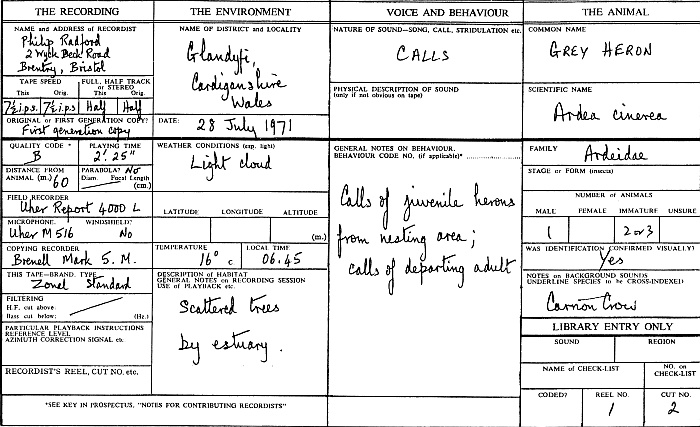Collections of wildlife recordings
Case Study: British Library of Wildlife Sounds, British Institute of Recorded Sound, London, England.
(a) Collection
A self-contained collection within the total holding of BIRS (67,000 hours), BLOWS has some 1,000 hours or 25,000 recordings covering well over 5,000 species. The collection consists of commercial recordings, copies of BBC material and privately-made recordings.
(b) Cataloguing Staff
The collection has no cataloguing staff as such, the total staff of BLOWS is one person. Documentation of non-commercial recordings relies on notes supplied by the individual responsible for the recording; BBC material relies on BBC catalogues. Overall documentation policy at BIRS is decided at Institute level (see g).
(c) Catalogue
The collection is covered by catalogue’s maintained at the Institute on cards and data sheets and by BBC Natural History Sound Archives catalogues. BLOWS publishes discographies for commercial recordings on particular subjects (e.g. African bird sound).
(d) Catalogue System
BLOWS will come within the scope of any long-term decisions taken about the cataloguing of the collections of BIRS as a whole. For the present, BLOWS documentation remains based on manual catalogues: a card catalogue for commercial recordings, and the 'Field and editing notes' data sheets developed for completion by field recordists for private recordings.
(e) Indexes
In so large a collection with so small a staff, various expedients are used to provide finding aids. Data sheets are filed by family and scientific name of species; they are thus effectively self-indexing. A separate card index is maintained for species covered by commercial recordings. BLOWS also annotates (annually) a copy of an authoritative published checklist of bird species to create a guide to its collection. Noted as desirable for inclusion when resources and capability permit are indexes by geographical location, habitat, type of sound, recordist etc.
(f) Examples
i. Field recording data sheet is illustrated as Figure 4.
 Figure 4
Figure 4
ii. The draft of a format for a computer catalogue derived from Example i is shown [below].
Ardea cinerea GREY HERON
Calls. 1 adult and 2 or 3 juveniles. Identified visually. Calls of juveniles from nesting area and calls of departing adult.
Background Carrion Crow.
Glandyfi, Cardiganshire, Wales. Scattered trees by estuary.
29 July 1971. 05.45. 50 Metres distant. Microphone on branch with 100 metre lead.
2'.25". B quality. Uher 4000 Report L. Uher M.516. First generation copy.
Dr Philip Radford. Tape. 19 cm/sec. ½ track Mono.
Reel 1, Cut 2. No. 1710.
(g) Comments
BLOWS demonstrates the kinds of ingenious expedient to which a collection committed to the provision of an adequate public service may have to turn in the absence of adequate staffing. Preliminary studies for computerisation in the mid-1970s suggested that the preparation of data on the extant collection for entry into a new system would require two years' work by a specialist cataloguer. It has also been calculated that the current accession rate - approximately 1,000 private, 500 BBC and 100 commercial recordings per year, - would justify, funds permitting, one full-time cataloguer.


